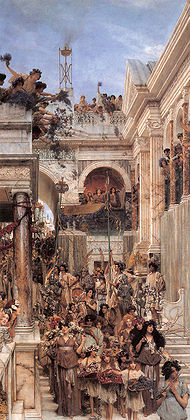- Cerealia
-
 Spring (1894) by Lawrence Alma-Tadema, depicting the Cerealia in a Roman street (J. Paul Getty Museum)[1]
Spring (1894) by Lawrence Alma-Tadema, depicting the Cerealia in a Roman street (J. Paul Getty Museum)[1]
In ancient Roman religion, the Cerealia was the major festival celebrated for the grain goddess Ceres. It was held for seven days from mid- to late April, but the dates are uncertain.[2]
The festival may have been founded as early as the Regal period. Its archaic nature is indicated by a nighttime ritual described by Ovid. Blazing torches were tied to the tails of live foxes, who were released into the Circus Maximus. The origin and purpose of this ritual are unknown; it may have been intended to cleanse the growing crops and protect them from disease and vermin, or to add warmth and vitality to their growth.[3] Ovid offers an aetiological explanation: long ago, at ancient Carleoli, a farm-boy caught a fox stealing chickens and tried to burn it alive. The fox escaped, ablaze; in its flight it fired the fields and their crops, which were sacred to Ceres. Ever since, foxes are punished at her festival.[4]
The Ludi Ceriales or "Games of Ceres" were held as part of the festival in the Circus Maximus. Ovid mentions that Ceres' search for her lost daughter Proserpina was represented by women clothed in white, running about with lighted torches.
During the Republican era, the Cerealia was organised by the plebeian aediles, Ceres being one of the patron deities of the plebs or common people. The festival included ludi circenses, circus games. These opened with a horse race in the Circus Maximus, with a starting point just below the Aventine Temple of Ceres, Liber and Libera.[5] After around 175 BC, the Cerealia included ludi scaenici, theatrical performances, held April 12–18. The plebeian aedile Gaius Memmius is credited with staging the first of these ludi scaenici. He also distributed a new commemorative denarius coin in honor of the event. His innovations led to his claiming to have presented "the first Cerealia."[6]
See also
References
- ^ Swanson, Alma-Tadema, p. 130
- ^ it may have started on April 11 and ended on April 19, or it may have started on the Ides of April, i.e. April 13, or even on April 7.
- ^ Barbette Stanley Spaeth, The Roman Goddess Ceres (University of Texas Press, 1996), pp. 36–37.
- ^ Ovid, Fasti 4.
- ^ T.P. Wiseman, Remus: A Roman Myth (Cambridge University Press, 1995), p. 137.
- ^ Spaeth, The Roman Goddess Ceres, p. 88.
External links
Categories:- Ancient Rome stubs
- Festival stubs
- Ancient Roman festivals
- April observances
Wikimedia Foundation. 2010.
